HIROSHIMA
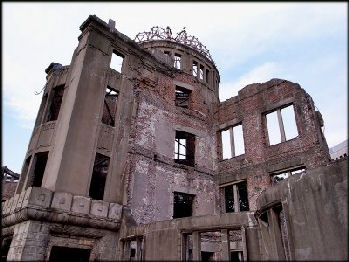
HIROSHIMA (two hours from Osaka by train) is a former castle town and the cultural, economic and political center of far western Honshu. Located on a triangular delta of the Otagawa River, with the Inland Sea on one side and the Chugoku Mountains on two sides, it has a population of 1.1 million people, and is the home of the Carp baseball team and Mitsubishi and Mazda plants and facilities. Mazda has their headquarters here and has a strong presence in the region. Their cars are visible on the area's roads.
Hiroshima is in the center of the National Park of the Seto Inland Sea and is the largest city of West Honshu. As the target of the first atomic bomb on August 6, 1945, Hiroshima is known throughout the world. Ninety percent of the city was destroyed that day, and the estimated loss of life is as high as 200,000 but with the exception of the Atomic Bomb Dome and the museums and memorial you would never know that.
During the reconstruction process after the atomic bombing, plans were made to create a city with much more space and greenery than other Japanese cities, and yes most of these plans came to fruition.Today, Hiroshima is one of Japan's nicest industrial cities. It was rebuilt from scratch after World War II under the guidance of 30 city planners who made room for parks and wide green boulevards. Hiroshima boasts 700 well-tended parks, an ultra-modern electric transit system, 500 bridges, and streets and boulevards lined with sycamores, ginkgo trees and white and pink oleanders. You can enjoy walks along green riversides in the middle of the city that include the city’s main sights: the Peace Park, the Atom-Dome and the Peace Memorial Museum. On the southern side of the city is a small peak with a scenic road that twists and turns to the summit.
Tourist Information Center is located on the second floor of Hiroshima Station, Hiroshima’s main train station, outside the ticket gate of the Shinkansen (bullet train) station along a passageway in teh station area. Maps, pamphlets, and various materials are available. The staff speaks English. Tourists can use the installed tablets which contain tourist information, as well as connect to public Hiroshima Free Wi-Fi). Visitors can get around by trams, buses and trains. Hiroshima Subway and Train Map: Urban Rail urbanrail.net; Hiroshima Tram Map: Urban Rail urbanrail.net; Accommodation: There are many business hotels and also some Japanese inns in Hiroshima. If you want to stay by the sea, hotels close to Ujina port sometimes have good deals and can be reached by bus from the station. From there, you can take a boat directly to Miyajima for about 2000 yen. Ryokan and Minshuku Japanese Guest Houses Japanese Guest Houses Budget Accommodation: Japan Youth Hostels Japan Youth Hostels Check Lonely Planet books
Getting There: Hiroshima is on on the main shinkansen route and is accessible by air and by bus and by train from Tokyo (five hours) and Osaka (one and half hours) and other Japanese cities. Shinkansen station and the main train station, with local train lines, are adjacent to each other. This is very convenient. In some cities like Osaka they are in different places. Lonely Planet Lonely Planet
Websites:Hiroshima Convention and Visitor’s Bureau hiroshimacvb.jp ; Explore Hiroshima hiroshima-navi.or ; Visit Hiroshima Official Prefecture Tourism site visithiroshima.net ; Gethiroshima.com:
gethiroshima.com/
Maps: PDF Tourist maps hiroshima-navi.or.jp and Wikimedia Commons commons.wikimedia.org ;
Sights and Entertainment in Hiroshima
Hiroshima has a lively nightlife scene. Most of the city's 3,500 bars, restaurants and nightclubs are concentrated in the Shintenchi, Nagaregawa and Yagenbira entertainment centers. For information on events and club dates check out local websites. The Hiroshima area is famous for oysters. Hiroshima Tourist Sights include a Holocaust Museum; a science museum, with a planetarium and hands-on displays; a zoo; a 45-acre botanical garden; an insect museum; a museum of contemporary art; and some shrines and temples.
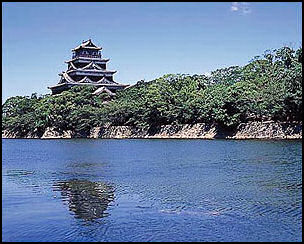
Hiroshima Castle was originally built in 1589 by Terumoto Mori, a feudal lord, and reconstructed in 1957. Known as rijo, "castle of the carps," it contains a good collection of swords, armor objects related to Hiroshima's history.
Hiroshima Prefectural Art Museum contains works by Monet, Renoir, Degas, Dali, Henry Monroe, Magritte, Calder and Picasso. A ticket to the museum includes admission to Shukkeien Garden, a beautiful landscaped garden built in 1621 with attractive ponds and streams made from water drawn from the Ota River. Shukkeien means “shrink-scenery.” The garden is modeled on Xihua in Hangzhou, China.
Kagura is one of Japan’s most ancient performing arts. Hiroshima Prefectural Art Museum/Hiroshima YMCA hosts performances of Kagura, Over a millennium old, Kagura is a theatrical dance form whose origins lie in ancient Shinto ceremony. The art form still thrives in Hiroshima and visitors can enjoy it during evening performance featuring strikingly colored costumes and bold movements and follow the story every step of the way, thanks to English-language guidance and subtitles. After-show you can ask the performers questions, try on the elaborate outfits and take photos. Location: 04 2-22 Kaminobori-cho, Naka-ku, Hiroshima-shi, Hiroshima /7-11 Hatchobori, Naka-ku, Hiroshima-shi, Hiroshima Website: hiroshima-kagura.com
Yamasaki Seifu Shinto Factory in Hiroshima shows how hair care and skin care products are made, and gives samples of basic beauty products and bath supplies. The factory has a popular rooftop garden, which is created as an environment conservation project. [Source: Akihito Teramura, Yomiuri Shimbun, November 23, 2012]
Hiroshima and the Atomic Bomb
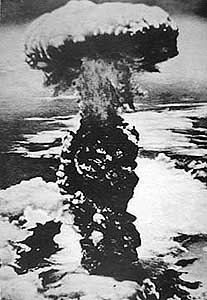
On August 6, 1945, a 10-foot-long atom bomb, code named "Little Boy," was dropped 31,600 feet above Hiroshima by American pilots in the “Enola Gay . The 9000-pound explosive, fueled by less than ounce of uranium, exploded 2,000 feet above the Motoyasu River, in the center of the city, with a force equal to 12,500 tons of TNT. An area of 3.9 square miles was flattened.
The population of Hiroshima before the blast was 400,000. Three month later it was reduced to 140,000. About 80,000 were killed outright and many thousands died later, mainly of leukemia. But a surprising number survived. including some that were within a mile of ground zero. About 45,000 survivors remain alive in Hiroshima today.
On one side of the Motoyasu River is burnt-out skeletal dome of the Industrial Exposition Hall (A-Bomb Dome), the only central city building whose framework survived the explosion. On the other side of the river is Peace Memorial Park. Except for these poignant reminders of the devastating event, Hiroshima looks like any other modern Japanese city.
Among the building that survived the blast and were rebuilt is the Bank of Japan Building on Rijo. It was about a 1,000 feet from ground zero. Although the inside was completely destroyed and 42 people in the bank were killed, the bank reopened two days after the blast.
Hiroshima now is regarded as a symbol of peace. In addition to Peace Memorial Park, there is also a 100-yard-wide Peace Boulevard. Peace education is part of the school curriculum and every country that conducts a nuclear tests receives a telegram of protest form the city's mayor.
Hiroshima Cycling Peace Tour gives you the deeper under standing of what happened on August 6, 1945 story. Over the course of three hours you will tour around the famous Atomic Heritage sites and visit lesser-known areas in the suburbs that were affected by the atomic bombing. Each site features unique stories told by a local Hiroshima guide. Address: 102 6-3-25 Yaga, Higashi-ku, Hiroshima-shi, Hiroshima; Website: attractive-j.com
Atomic Bomb Dome
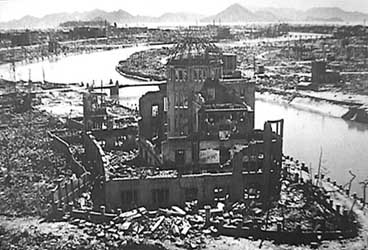
Atomic Bomb Dome (Genbaku Domu-mae Electric Railway Station) is Hiroshima's most famous landmark and the most vivid reminder of the nuclear blast. Resembling a bombed astronomical observatory, it was once the Hall of Industrial Promotion. Ground zero was just 160 meters east of the dome. No one inside survived.
The structure — built in 1915 and designed by the Czech architect Jan Letzel — is floodlit at night and fronted by thousands of origami cranes. It survived the blast as well as it did due to heavy use of steel and concrete in construction and because the blast took place almost directly above it and was spared some of the strongest shock waves and fireballs. Ironically the building is badly in need of restoration work despite repairs done in 1967, 1990 and 2003.
Hiroshima Peace Memorial (Genbaku Dome) was designated a UNESCO World Heritage Site in 1996. According to UNESCO: The Hiroshima Peace Memorial (Genbaku Dome) is the only structure left standing near the hypocenter of the first atomic bomb which exploded on 6 August 1945, and it remains in the condition right after the explosion. Through the efforts of many people, including those of the city of Hiroshima, this ruin has been preserved in the same state as immediately after the bombing. Not only is it a stark and powerful symbol of the most destructive force ever created by humankind, it also expresses the hope for world peace and the ultimate elimination of all nuclear weapons. The inscribed property covers 0.40 ha in the urban centre of Hiroshima and consists of the surviving Genbaku Dome (“Genbaku” means atomic bomb in Japanese) within the ruins of the building. The 42.7 ha buffer zone that surrounds the property includes the Peace Memorial Park.
“The most important meaning of the surviving structure of the Hiroshima Peace Memorial is in what it symbolizes, rather than just its aesthetic and architectural values. This silent structure is the skeletal form of the surviving remains of the Hiroshima Prefectural Industrial Promotional Hall (constructed in 1914).. It symbolizes the tremendous destructive power, which humankind can invent on the one hand; on the other hand, it also reminds us of the hope for world permanent peace.
“The Hiroshima Peace Memorial (Genbaku Dome) is a stark and powerful symbol of the achievement of world peace for more than half a century following the unleashing of the most destructive force ever created by humankind. IT has been preserved as a ruin. It is all that remains of the Hiroshima Prefectural Industrial Promotional Hall ‘Hiroshima-ken Sangyo Shoreikan’ after the 1945 nuclear bomb blast. Inside the property, all the structural elements of the building remain in the same state as immediately after the bombing, and are well preserved. The property can be observed from the outside of the periphery fences and its external and internal integrity is well maintained. The buffer zone, including Hiroshima Peace Memorial Park, is defined both as a place for prayer for the atomic bomb victims as well as for permanent world peace.
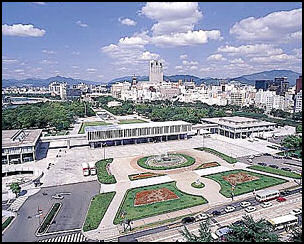
”In the last three conservation projects (1967, 1989-1990 and 2002-2003), minimum reinforcement with steel and synthetic resin was used in order to preserve the condition of the dome as it was after the atomic bomb attack. The Hiroshima Peace Memorial (Genbaku Dome) stands in its original location and its form, design, materials, substance, and setting are all completely authentic. It also maintains its functional and spiritual authenticity as a place for prayer for world peace and the ultimate elimination of all nuclear weapons. The Hiroshima Peace Memorial (Genbaku Dome) is designated as a historic site under Japanese 1950 Law for the Protection of Cultural Properties, and is managed by Hiroshima City under the guidance by the Hiroshima Prefectural Government and the Government of Japan. Financial and technical support is available from the Government of Japan. The park management office of Hiroshima City is located inside the Hiroshima Peace Memorial Park, and daily maintenance is conducted in cooperation with the division in charge of protecting cultural properties.” Website: UNESCO website unesco.org ; Wikipedia Wikipedia ;
A daily illumination event involving trees string with LED lights around the Atomic Bomb Dome in Hiroshima that began in December 2016 raised questions over whether it was appropriate to promote tourism in the area around the dome and how to address the dome’s role as a tourist spot. The municipal government installed some 45,000 LED lights, mainly on trees around the Atomic Bomb Dome, and added electrical ornaments that included representations of large orizuru (paper cranes), which symbolize longevity in Japan. At least one hibakusha (atomic bomb survivor) raised concerns about holding the event as part of a tourism promotion campaign The illumination started at 5:30pm and lasted for five hours. One critic of the lights told Jiji Press the dome “is not a tourism spot.” Kunihiko Sakuma, 72-year-old head of an atomic bomb survivor group in Hiroshima, said: “The illumination of the dome, a place to mourn for the victims, is undesirable.” [Source: Jiji, February 2, 2017]
Hiroshima Peace Memorial Park
Peace Memorial Park (across the Motoyasu River from the Atomic Bomb Dome) occupies a triangular piece of land, where the Motoyasu, Han and Ota Rivers all come together. Designated a UNESCO World Heritage Site, it was once the prosperous heart of Hiroshima and had 710 buildings. The rebuilt T-shaped Aioi-bashi Bridge was lined up in the sites of the “Enola Gay bombardier who aimed the bomb.
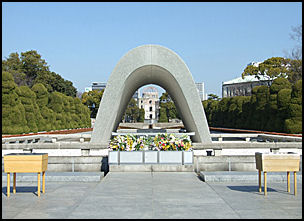
Outside the museum is the Flame of Peace which is designed to continually burn until a real and continuous peace reigns over the whole world and the last remaining nuclear weapons are destroyed. Not far away is a simple concrete arch and a plaque marking ground zero of the blast.
Many people come to pray at the Memorial Cenotaph, which contains a "Books of the Past" with the names of all the known victims. In 2006, 5,350 names were added bringing the total to 247,787. Other memorials include the Statue of the Mother and Child in the Tempest; and the Fountain of Prayer. There is a clock tower, a bell and walkways where young Japanese couples go for romantic strolls on the weekends.
The Children's Peace Monument was erected by the boys and girls of Japan and dedicated to the world and world peace. It was inspired by the story of Sadako Sasaki, a child who survived but came down with leukemia and vowed to fold 1,000 origami cranes (a symbol of longevity) before she died. She only completed 644. Children in her school folded the remaining 356. Publicly surrounded the story inspired a wave of origami crane folding.
The Hiroshima Peace Memorial was vandalized by an ultrarightest in 2005 and an arsonist in 2003, when about 140,000 paper cranes were set on fire and burned in about 10 minutes. A Japanese university student was arrested for the crime. He said he was frustrated by his inability to find a job. The monument now has a a series of eight gates created to commemorate the 60th anniversary of the atomic bombing. Websites: Wikipedia Wikipedia ; UNESCO World Heritage site: UNESCO website
Peace Bridge and West Peace Bridge were designed by the famed Japanese artist and architect Isamu Noguchi, who visited war-ravaged Hiroshima in 1950 when Kenzo Tange invited him to design bridges connecting the river island that is home to the Hiroshima Peace Memorial Park to the rest of the city. The two bridges are both grandiose, organic forms looking upwards to the sky; the West Peace Bridge titled Yuku (to depart) was designed to resemble the bow of a Japanese ship, and the Peace Bridge or Tsukuru (to build) symbolizes the rising sun. [Source: JNTO]
Hiroshima Peace Memorial Museum
The Hiroshima Peace Memorial Museum (in Peace Memorial Park) contains a large collection of photographs of victims and damage, and objects that survived the blast such as scorched pieces of clothing, a burnt stuffed horse, and several watches that stopped at 8:15am, 32 seconds, August 6, 1945, the moment the bomb exploded. As of 2010, 60 million people had visited the A-bomb museum in Hiroshima. Of the 1.5 million people that visit the museum each years half are students and only 80,000 are foreigners.
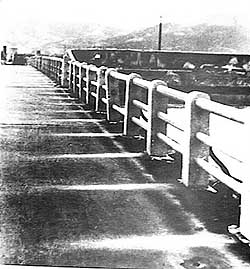
bomb shadows Many Japanese school children visit the museum and listen to first hand accounts to elderly survivors. In the basement of the museum is a massive card catalogue that lists the names of all the people who died in the Hiroshima blast, the cause of their death, and the names of the people who found the body. The ashes of 70,000 unidentified people are kept in solemn rooms within the Atomic Bomb Memorial Mound.
The East Building was renovated and underwent seismic retrofitting between 2014 and 2017. The Main Building was also renovated and reopened in 2018. Labels in museums are in Japanese and English. Portable audio guides can be rented in several languages. The audio tapes provide more information and go into more detail than the labels.
Getting There: From the JR Hiroshima Station: 1) Take a tax (15 minutes), about US$10 to US$12; 2) By Bus (20 minutes) Take No. 24 Hiroshima Bus for Yoshijima from A-3 at the south exit of Hiroshima Station, and get off at "Heiwa kinen koen". 3) By sightseeing loop bus “Hiroshima Meipuru~pu”/ (17 minutes): Take a “Hiroshima meipuru~pu” at the Shinkansen-guchi exit of Hiroshima Station, and get off at “Heiwa kinen koen”. Both the orange line and green line stops at “Heiwa kinen koen”. 4) By Streetcar (25 minutes): Take a streetcar for Hiroshima Port , and get off at "Fukuro-machi". Take a streetcar for Nishi-Hiroshima , Eba or Miyajima-, and get off at "Genbaku Domu Mae". Website: Peace Memorial Museum official site hpmmuseum.jp ;
Exhibits in the Hiroshima Peace Memorial Museum
The Hiroshima Peace Memorial Museum houses life-size dioramas of ghostly survivors with shreds skin, burnt clothes, and blackened bodies, and audio visual presentations with newsreels showing shadows imprinted onto concrete by the intense heat from the blast and films that describe how radioactive "black rain" fell all over the city.
Visitors enter the first floor of the East Building, where models, videos and photographs are used to describe what Hiroshima was like before and after the blast and give some history behind the tragedy. The exhibit points that Hiroshima was a military supply and command center, there was widespread use of forced labor and that city hosted a festival celebrating the capture of Nanking in 1937. Visitors walk upstairs to the second floor of the East Building where there are exhibits on the nuclear age and the peace and anti-nuclear movement. A corridor links the East Building with the West Building.
The West Building displays A-bomb artifacts and materials designed to convey what Hiroshima was like when the explosion occurred. The displays include a charred lunch box, burned student uniforms, bottles melted by the heat, shudders bent by the blast, fused utensils. shreds of cloths, black rain stains on a white wall and a human shadow left on a stone from a person sitting nearby, and paper cranes folded by a girl who died of leukemia at the age of 10, eight years after she was exposed to radiation in the blast. There are some shocking photographs, many of children, with horrible injuries.

cloth-apptern burns A video theater shows films such as “Hiroshima: A Mother’s Prayer and “Hiroshima and Nagasaki: The Harvest of Nuclear War in English and Japanese. Some of he most gruesome images are in these films. One scene shot in a makeshift hospital features a woman who was looking towards the bomb as it exploded. Doctors open one of her eyelids with tongs to reveal an eyeball that has been melted by the heat.
In 2017, The Hiroshima Peace Memorial Museum’s renovated East Building added a panoramic display of computer-generated images of the city soon before and after it was struck by the atomic bomb. Jiji Press reported: ““White Panorama,” five meters in diameter, showcases images derived from pictures taken by the U.S. military on July 25 and August 11, 1945, projected by six lasers onto a diorama of the city. The 90-second projection depicts how the city was devastated by just a single bomb in the closing days of World War II. The museum has also introduced a new exhibit in which visitors, especially those with visual impairment, can experience the difference between two models of the Atomic Bomb Dome, a UNESCO World Heritage site, before and after the atomic bomb was dropped. Paper cranes that former U.S. President Barack Obama folded and brought to the museum on his landmark visit in May 2016 will also be displayed, in the admission-free area on the first basement floor. [Source: Jiji Press, April 26, 2017]
Tripadvisor: Hiroshima Peace Museum, Japan’s Top Travel Destination
Japan Today reported in 2013: “The Hiroshima Peace Memorial Museum claimed the top spot for the second consecutive year on Trip Advisor Japan’s list of the most popular sightseeing spots for foreign tourists. One Trip Advisor user described it as “sad, informative and a must-see.” Trip Advisor Japan gathered user comments and evaluations in 20 different languages on their website to determine the rankings. [Source: Japan Today, August 25, 2013 ]
According to Chugoku Simbun: The number of visitors to the Hiroshima Peace Memorial Museum in fiscal 2018, between April 2018 and March 2019, totaled 1,522,453 people, the museum said. On his visit to the museum in 2013, Roland Kelts wrote in The New Yorker: “The mood was as solemn as I expected, but the place was crowded and not very peaceful. Visitors were silently urged to go with the flow, move in step with others and not linger too long. The displays were impressively well kept—maybe too well kept. There were life-size dioramas of the victims trudging barefoot through ashen sludge, shredded and bloodied; massive models of the city as it was, pinpointing the exact location of ground zero; bent and crushed watches and clocks frozen to the moment—8:15 A.M., August 6, 1945. The feeling that all the carefully curated and eye-catching exhibits sometimes felt like part of a Hiroshima theme park was probably unavoidable. [Source: Roland Kelts, The New Yorker, August 6, 2013]
“One object pierced me. I kept circling back to it, leaving and rejoining the flow, nodding politely to the guards as I ducked past: a neatly folded Japanese schoolboy’s uniform—modeled, as they are today, on nineteenth-century European naval dress—had been blown out in quarter-sized patches from the inside, so that sharp spikes of its fabric reached up toward the glass and viewer. Part of my fascination was personal. I’d been teaching at a few Japanese junior and senior high schools that year where the boys wore the very same jackets to class each day, with their formal high-necked collars and rigid lines projecting a sense of adolescent duty and conformity. But it was also the one artifact that made me imagine being that specific boy on that specific morning, buttoning up that jacket and walking to school, and what it might feel like to have your body blown apart from within, as if the bomb had detonated inside your chest and bowels.”
Rivers and Boat Trips in Hiroshima
Hiroshima is a city that is built around water; some parts are even below sea level. The Ota River splits into six arms to form a large delta, where the city is situated. The Peace Park, the Atom-Dome and the Peace Memorial Museum are all located at the north end of an island formed by the Ota River and the Motoyasu River. Open cafes are situated along the river close to Hiroshima Station. To reach them take the Main (South) Exit of Hiroshima station and go along the underground passage to Ekimae-Ohashi Ekimae-Ohashi Bridge, over the river, past the 21 Century Hotel, until you hit the streetcar line. Follow the rails to the right, cross the next river and you will find the place.
Gangi are steps that lead into the water-this used to be the common connection between land and water along rivers and sea coasts. In Hiroshima, over 100 Gangi were found to be usable. Gangi Taxi will take you around the rivers and to a choice of 50 landing places for 500 Yen per 10 minutes. A Gangi Taxi is a small, open boat, so it might not run during bad weather!
River cruises are available on the city's numerous waterway. Hiroshima River Cruise boats leave from Motoyasu-bashi Pier near the A-bomb Dome. Boats leave port once every 40 minutes from 10:00am to 4:20pm. Travel time is approximately 25 minutes. However, services may not be provided due to reasons related to the tide level Cruising is a fun way to see Hiroshima. The pier is a two minute walk from "Genbaku Dome-mae" streetcar stop of Hiroshima Electric Railway, which can be accessed from JR Hiroshima Station. Closes Wednesday Admission: Adults: 1,200 yen, Children (aged 3 to elementary school student): 600 yen. Website: hiroshima-water-taxi.com , Aqua-net runs a variety of boat trips in the rivers, canals and bays in Hiroshima. Website: aqua-net-h.co .
Hiroshima is in the center of the National Park of the Seto Inland Sea A variety of half-day cruise sets are available from Hiroshima. A very simple way to cruise the Seto Inland Sea is the regular ferry (10 boats per day) from Hiroshima to Matsuyama on Shikoku. On the comfortable 3 hour ride, you can enjoy the landscape of islands and sea at its best, sitting outside and enjoying the breeze. If you don’t have much time, the high-speed boat (running every hour) will take you there in 75min., for more than double the price. Setonaikaikisen is company that runs cruises, ferries and high-speed boats around Hiroshima. Check the site for schedule for the Hiroshima-Matsuyama ferry and Hiroshima-Matsuyama high speed boat Websites: setonaikaikisen.co.jp
Boats to Miyajima from Hiroshima run between the Pier in front of the Resthouse in Peace Park and Miyajima in a 45 minute trip. While the price is a bit steep — ¥2200 one way, ¥4000 return, Miyajima ferries, a half hour from Hiroshima cost ¥180 — it is a nice way to enjoy a rest and the change of landscape from the urban rivers to the islands of the Seto Inland Sea while moving from one site to the other. Boats run five times a day. River cruises also run from the same pier. Please make a reservation and check departure times, as they vary according to tide conditions. Website: aqua-net-h.co .
Miyajima Ferries leave from Miyajimaguchi Passenger Terminal which is about a half hour by train from Hiroshima City. The trip cost s ¥180 (US$1.70) yen one for adults and ¥90 for children. The ride takes about 20 minutes and offers great views of Miyajima. Getting There: The ferry is located at Miyajimaguchi Station on the JR San-yo Main Line. From Hiroshima Station take a train bound for Iwakuni on the JR San-yo Main Line. Get off the train at Miyajimaguchi Station. Train travel from Hiroshima Station to Miyajimaguchi Station takes about 28 minutes. Leave JR Miyajimaguchi Station through the ticket gates, and walk through the underpass to the Miyajimaguchi Passenger Terminal Building.
Mazda Museum and Factory Tours
Mazda Museum and Tours are at the Mazda headquarters. At the Entrance Hall to the museum you will see the latest Mazda vehicles and special events. There is a display that covers the company’s history of Mazda since the 1920s with with an exhibit of historic vehicles. A section on Mazda rotary engine technology, the pride of Mazda, is featured, with a the racing car the won at Le Mans is on display. In the Technology section the vehicles manufacturing process is described. Learn how the CX-5 is built.
The tour covers a look at U1 Assembly Line, were you get a good look at the impressive vehicle assembly process. Mazda's private port can be seen from the observation deck. The Future Area introduces Mazda’s approach to the environment and its efforts to realize its goal of reducing CO2 emissions. At the.Mazda Museum Shop you can buy Mazda company merchandise as well products for the Hiroshima Toyo Carp baseball team and Sanfrecce Hiroshima soccer team, both of which are supported by Mazda.
Tours: Reservations can be made on online or by telephone (082-252-5050) by calling Monday through Friday between 8:30am 12noon and between 12:45pm and 5:00pm. Please check available tour times via the reservation system on this website. The Japanese tour is at 1:30pm and the English tour is at 10:00am. Admission is free. The length of tour is one hour to 90 minutes. By public transportation from Hiroshima Station. Getting There: From Hiroshima Station. Take an eastbound train on the Sanyo or Kure line and get off at Mukainada Station. It is a 5 minute walk from the south exit of the train station. Please be aware that express trains do not stop at Mukainada Station. Website: Mazda Museum .mazda.com
Hiroshima Museum of Meteorology and Its Typhoon Simulator
Hiroshima City Ebayama Museum of Meteorology was Japan's first "meteorology-themed" museum. Here, you can have fun while learning about weather with hands-on exhibits, including the Toppu "Wind Capsule", which lets you experience the strength of the wind at speeds of 20 meters per second (72 kph), and the "Typhoon Box", where you can feel what it's like inside a typhoon or a cloud. The building housing the museum was built in 1934 and is one of the animals few buildings which was damaged by the atomic bomb that is still standing.
Nobuyuki Nakata wrote in the Yomiuri Shimbun, “After I stepped inside the “Toppu (gale) Capsule,” where visitors can experience extremely strong winds, a rotor began to rotate. As the thunderous sounds grew louder, the wind speeds displayed in the room rose from 5 meters per second (18 kph) to 20 meters per second (72 kph).. Starting off slowly, the winds didn’t feel very strong at first. But it soon picked up enough speed to make my facial muscles twitch, and it eventually became impossible to keep my eyes open. At full force, my body finally started to stagger. In weather terminology, a tropical depression that causes winds higher than 17 meters per second is known as a typhoon. And feeling this artificial wind is like being in a typhoon. [Source: Nobuyuki Nakata, Yomiuri Shimbun, August 20, 2014]
““Typhoon Box” also offers a novel experience, giving visitors a taste of what walking inside a cloud feels like. Misty water is sprayed in a way that resembles clouds, creating the sensation of floating in the air. Whirlwinds soon blow the clouds away, revealing the eye of the typhoon at the center of the space. The museum also exhibits a device that generates artificial lighting at 300,000 volts.
An exhibition titled “Umi no Fushigi o Saiensu” (Scientific look at the wonders of the sea) (a temporary exhibit]...includes a device display showing the mechanisms behind a tsunami. Artificial waves in a tank full of water can be seen rolling towards the shore. The museum building itself is also noteworthy. Built in 1934, it was used as the Hiroshima Local Meteorological Office until 1987....The building was affected by the atomic bombing on August 6, 1945. Window shards embedded in walls and crooked window frames were preserved, showcasing the extent of damage that was suffered at the time.”
Science shows and science workshops are held on Saturdays, Sundays and holidays. Special exhibitions that are held in August and January through March. Location: 730-0835 1-40-1 Eba-minami, Naka-ku, Hiroshima-shi, Tel: 082-231-0177; Hours Open: 9:00am-5:00pm lLast entry: 4:30pm) Closed Mondays (open when Monday falls on a national holiday), the day after a national holiday, December 29 to January 3, Admission: Adults-100 yen; Children-50 yen. Explanations, experiments and more can be arranged when making group reservations (requires reservation by telephone). Getting There: Approximately 1,500 meters from "Eba Station", accessible from Hiroshima Station by taking a Hiroshima Electric Railway streetcar bound for Eba. (Located atop Ebayama at an elevation of 30meters). Or, accessible by taking a Hiroden bus bound for Eba from "Kamiya-cho Station". Website: ebayama.jp
Image Sources: 1) 11) Ray Kinnane 2) 5), 6), 7) Hiroshima Convention and Visitor's Bureau 3) 4) 8), 9) Gensuikan 10 Aomolife 13) Visualizing Culture, MIT Education, 14) Wikitravel, 15), 16), 17) Shimonoseki city site
Text Sources: JNTO (Japan National Tourist Organization), Japan.org, Japan News, Japan Times, Yomiuri Shimbun, Japan Ministry of the Environment, UNESCO, Japan Guide website, Lonely Planet guides, New York Times, Washington Post, Los Angeles Times, National Geographic, The New Yorker, Bloomberg, Reuters, Associated Press, AFP, Compton's Encyclopedia and various books and other publications.
Updated in July 2020
